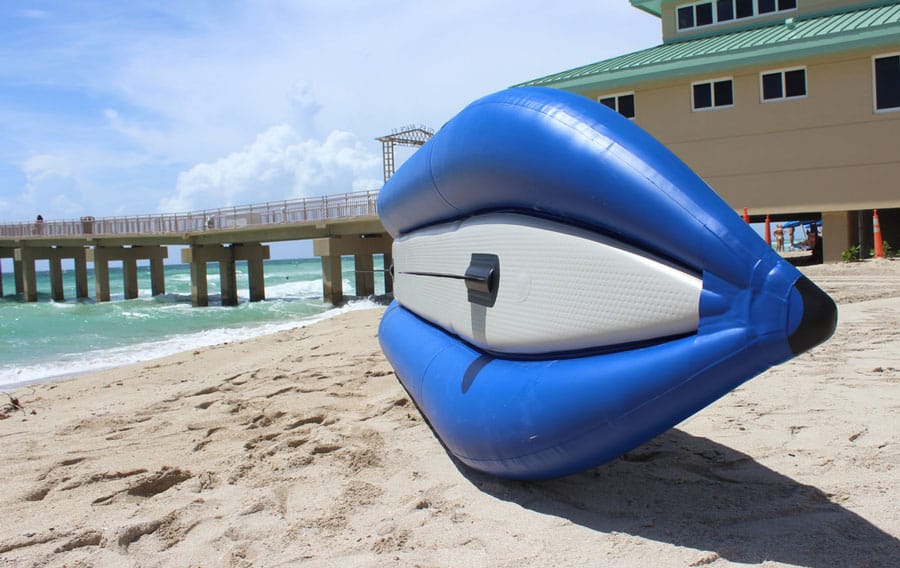Despite what a lot of people think, inflatable kayaks are incredibly durable and safe. They are built to withstand tough conditions these days, thanks to modern materials and manufacturing processes.
You can take them on rivers, lakes or even out to sea without fear of them popping and sinking.
If you’ve never sat in one before, I think you will be surprised at how stable and rigid an inflatable kayak feels out on the water.
Contents
Is inflatable kayaking safe?
If you take proper precautions to stay safe on the water (just like you would in any other boat), inflatable kayaking is perfectly safe.
If you know what you’re getting into, you can choose an inflatable kayak developed specifically for that purpose. This pertains mostly to whitewater kayaking of course. While purpose-built whitewater kayaks can perform well even in class IV whitewater, most inflatable kayaks are not built for harsh conditions or rough water.
Be sensible. Use caution if you’re paddling on a river with rapids, and stay away from things that are likely to harm you or your kayak.
What activities are safe with an inflatable kayak?
You can pursue any water activity you would normally be able to do with an inflatable boat as well.

Lake paddling and gentle river cruises are safe with any inflatable kayak.
Fishing from an inflatable kayak is also a great pastime, several brands have developed kayaks like these aimed specifically at fishermen.
If you want to go whitewater kayaking, you will need a kayak made specifically for this purpose though.
The same goes for heading out to sea with a kayak. You can get inflatable kayaks specifically made for use on the ocean, such as these.
How long do inflatable kayaks last?
Modern inflatable kayaks will easily last 7-10 years with proper care, similar to the lifespan of an inflatable boat.
This depends on proper maintenance though. If you don’t take care of your kayak, it will not last more than 2 years in extreme cases.
Are inflatable kayaks durable?
Inflatable kayaks generally hold up very well under normal wear and tear.
Unlike rubber pool toys, inflatable kayaks are made with multiple layers of thick coated materials, like vinyl and polyester. These materials can take a beating, they are tough and durable.
In fact, some are even built with aluminum parts to increase stability and rigidity.
Do inflatable kayaks pop or puncture easily?
Thanks to modern materials and manufacturing technology, inflatable kayaks have incredibly strong exteriors. Punctures are rarely an issue.
Even if you brush up against tree branches or rocks, you will float away without any serious repercussions. The heavy-duty outer shell bounces right off rocks most of the time.
But of course, there are exceptions and accidents.
You’ll certainly be able to puncture it if you try hard enough:
- Seams can tear open causing air to leak out.
- Or a sharp rock hits the kayak in just the right angle, it might poke a hole.
Even though they are not common, punctures can happen. But if you’re just a little careful, your kayak will last a long time without any tears or punctures.
In the event that you get a small patch kit, most inflatable kayaks are easily repairable with it.
But even if it punctures, it won’t pop and explode like a balloon. It will lose air slowly, giving you ample time to get to shore.
How stable are inflatable kayaks?
After your kayak is pumped, exactly how stable will it be? When trying to stand in it, will it fold up and collapse under you, sending you to the bottom of the sea?
After proper inflation, inflatable kayaks become remarkably stiff. They usually do not feel much different from regular hard-shell kayaks.
You will be surprised at just how strong and rigid these kayaks can be once they are inflated. Proper inflation is important. Both under inflating and over inflating an inflatable watercraft can lead to dangerous situations.
The manufactures have developed several was of increasing the rigidity of inflatable kayaks:
- Some utilize small inflatable sections that behave like support beams
- Some have a metal framework
- Some have drop-stitched high-pressure air floors
All 3 of these methods act as firm stabilizers. They keep the kayaks stable and firm as you paddle or drift on the water.
Can an inflatable kayak sink?
One of the many advantages of inflatable kayaks is that they are incredibly buoyant. Inflatable kayaks with multiple air tubes have the benefit of being filled with air, making them easier to keep afloat even in the unlikely event you capsize.
The reason for this is that the majority of inflatable kayaks have 3 separate air chambers. One for each side and one for the floor.
If you get an air leak in one of the air chambers, you will still have two others that will stay inflated and keep you above water.
In contrast, those who have capsized in a regular hardshell kayak know, that emptying the boat of water and getting back in can be a tiring hassle.
What if the kayak fills up with water?
If you’re asking this question, you’re probably going whitewater kayaking in a specialized inflatable kayak.

Because inflatable kayaks don’t have an enclosed cockpit, you may think that inflatable kayaks will fill up with water easily. Or at least easier than enclosed hardshell kayaks.
Rest assured, a good whitewater inflatable kayak is self-bailing.
There are holes in the seams of the boat that allow any water to quickly drain out.
Are inflatable kayaks maneuverable or sluggish?
Well-made inflatable whitewater kayaks track well across the water and allow you to maneuver quickly on the river.
They are not rubber rafts used in pools.
Can kids and older folks handle an inflatable kayak?
The fact that they are so stable makes them ideal for people of all ages. The smaller, lighter kayaks will be easier to paddle and maneuver.
If an older person or a child will be handling the kayak, I would suggest sticking with the lighter weight models. They are easier to paddle and still safe.
Are inflatable kayaks safe in the ocean and sea?
Ocean and sea water can become dangerous very quickly. Wind, waves and currents introduce an element of uncertainty when using smaller watercraft, like an inflatable kayak.
You should only set out on the ocean in seaworthy boats after proper preparation (weather forecasts, tides, currents) and with proper gear (radio, life jacket, water, sun protection, etc).
Only a select few inflatable kayaks are seaworthy.

Inflatable kayak safety tips
The safety of kayaking really comes down to how you prepare and handle yourself out on the water.
Here are a couple tips to keep you safe in your inflatable kayak:
- Always make sure your inflatable kayak is inflated to full capacity. If there is not enough air in it, it will not be as rigid as it should be and therefore could be quite sluggish.
- After inflation, check for signs of air leaks.
- Always pack your pump and repair kit in a dry bag and bring it in the inflatable kayak with you.
- Always load your kayak carefully so that the weight is distributed evenly. More weight at the back is better than more weight at the front.
- Always wear a life vest, even if you are a good swimmer. Here are some inexpensive and safe ones.
- Always stay close to shore.
- If you see a wave coming, turn your kayak so that you face the wave and ride it out. If you take it sideways, you might be overturned.
- Don’t drag your inflatable kayak over rocks & gravel, and don’t run into sharp objects.
- Don’t paddle alone or without telling someone where you are going.
- Don’t fall asleep in your kayak. The gentle rocking of the water is very peaceful, but you never know where you will wake up.
- Always bring
- clean drinking water,
- a hat and sunscreen to protect yourself from the sun,
- a safety whistle,
- and your cell phone.





